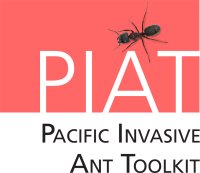Preparing samples for identification
Many experts will be willing to identify ants for you, if you send them samples or an image of the ant(s).
Capturing images of ants
| Getting enough detail to identify very small ants often requires a high-end camera. It is often difficult to get a good image of a small ant with a compact camera.
Many modern smartphone cameras have a selective focus function that can help you get sharp up close images when you tap on the screen to focus. The image on the right was taken with a smartphone. This may be enough for larger ants. And in some cases may be enough for smaller ants too, along with observations of behaviour (e.g. stinging, crazy movements etc.) to tell whether it is one of the five worst threat ants. Include something to give an idea of the size of the ant. It doesn't have to be a ruler - the end of a pencil or a fingernail are also good. |

Yellow crazy ants for identification (© Monica Gruber, Pacific Biosecurity) |
Include a number of ants in the picture so that they can be seen from different angles. It might take a few attempts to get a good image, but trying to get the best image possible will help with identification.
Preserving and sending samples
Biosecurity regulations of importing countries require that ants are dried or preserved in some way. The best way to preserve ants is to have them in ethanol (or some other alcohol), or to pin them and dry them.
Pinning (download 4 MB) requires a degree of skill. And sending pinned ants requires them to be specially packaged so they don't get crushed.

Examples of tubes used to preserve, store and send ants (© Monica Gruber, Pacific Biosecurity) |
Sending tubes of ants in ethanol is quite easy, but the ethanol must be drained off before shipping. This is because airlines ban the transport of ethanol (it is flammable and so classed as a dangerous good).
Many types of tubes are available (left), but any with a good sealed lid are fine. The tubes need to be packed in a way so that they are not crushed. |
|
But if you don't have any ethanol, an easy way is to kill the ants, leave them to dry, and then enclose them in tape (right). The samples can then be sent in a standard envelope through normal mail. Make sure you follow the regulations of the country you are sending to. The expert you send the ants to will let you know what is needed. Often this requires a letter or note describing how the ants were preserved (e.g. with ethanol or drying). |
Ants secured in tape for identification (© Monica Gruber, Pacific Biosecurity) |
Information Sources
PII. 2013. Delimiting surveys for invasive ants. Pacific Invasives Initiative, Auckland, NZ
Shattuck. 1999. Australian Ants: Their biology and identification. Monographs on Invertebrate Taxonomy, pp 226
Walker, Crosby. 1988. The preparation and curation of insects. DSIR Information Series 163, Wellington, pp.91
Content reviewed by Eli Sarnat, Antwork Consulting, LLC, October 2016

